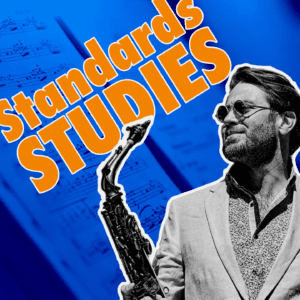Hi !
“Body and Soul” is a popular song and jazz standard written in 1930 with music by Johnny Green and lyrics by Edward Heyman, Robert Sour and Frank Eyton. It was also used as the musical theme and underscoring in the American film noir boxing drama Body & Soul (video in the comments section!).
Louis Armstrong was the first jazz musician to record this song, in October 1930, but it was Paul Whiteman and Jack Fulton who popularized it in the United States.
“Body and Soul” is one of the most recorded jazz standards, and multiple lyrics have been written for it.
Video lessons:
Lyrics:
My heart is sad and lonely!
For you I sigh, for you dear only
Why haven’t you seen it?
I’m all for you, Body and Soul
I spend my days in longing
And wondering why it’s me you’re wronging
I tell you, I mean it
I’m all for you, Body and Soul!
I can’t believe it
Its hard to conceive it
That you’d turn away romance
Are you pretending?
It looks like the ending!–
Unless, I can have
One more chance to prove dear..
My life a wreck you’re making!
You know I’m yours
For just the taking
I’d gladly surrender
Myself to you, Body and Soul!




28 comments on “Body And Soul”
Watch the movie!
hi patrick, the sound is back! Please confirm it’s good for you as well, thank you!
Hi Patrick, just to update you that I noticed today the sound is off also on my end on the first video. we are investigating what is causing this bug and hopefully this will be resolved quickly. Thank you!
Hi Patrick, sound is fine on each lesson, double check the volume bar or your computer volume 🙂
Alex, the harmonic analysis sheet is really only the chord progression. Should we make an attempt at writing the roman numeral analysis and post it here? If yes, how do we attach a PDF?
hey Noah, it’s in the video 🙂
Check out Alain on baritone!
Very good. Nice sound and solo.
What is the playalong . Definitevely is not Ireal
Nuno, I think this is an Aebersold, but the best iPad play-along is Mapping Tonal Harmony Pro (mDecks), which has an add-on for $20 that includes 1300 jazz standards. You can tranpose keys and instruments, and change tempo very easily.
Pierre again!
Me, myself, and my saxophone…
Here is Pierre:
Here I am practicing Body And Soul 🙂
Los acordes m7b5 siempre los pensaba como IIm7b5 de una escala menor. Veo que estos acordes se han analizado como VIIm7b5 . Mi pregunta es si es mejor ver estos acordes como un VII de una escala mayor en lugar de un II de una escala menor?
Sorry, here my question un English….
I used to think the m7b5 chords as IIm7b5 of a minor scale. I see that these chords have been analized as VIIm7b5. My question is whether it is better to see these chords as a VII of a major scale rather than a II of a minor scale?
Thank you Alex
Hi Dulce! I answered your question, check out the video #6 in the playlist above and the PDF. Let me know if you have any other questions 🙂
Hi Alex, the explanation about the m7b5 was impressive, I really had no idea about the other possibilities (Ceora, for example) thank you very much for this. I have a lot of work to do .. Now I would like to know how do you approach diminished chords? I have always had doubts with which scale to use and I use arpeggios to solve them. Thank you again!
Hi Dulce! you can find out about the diminished scales here:
https://jazzvideolessons.net/portfolio-items/the-diminished-scale/
Pierre Gros I just updated the lesson here with the technique exercise using transposing cycles. Enjoy 🙂
For the horn players, here is a version by Dexter Gordon recorded live at Keystone Korner in San Francisco in 1978. This version was highly influenced by Coltrane.
Yeah, what an amazing intro!
I didn’t knew this version and this is amazing.
I think this kind of version is the one I will have to practice later. It makes you want to play like him with a lot of notes and lead you away from being able to keep clear picture with what you are doing.